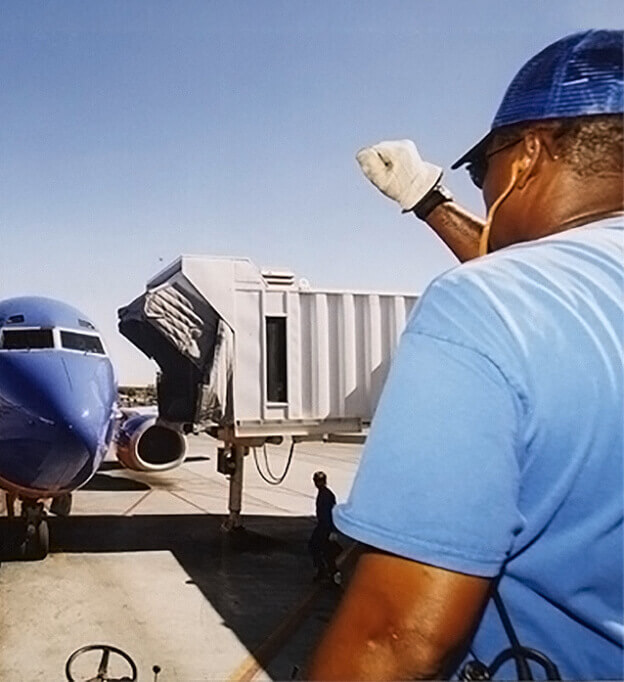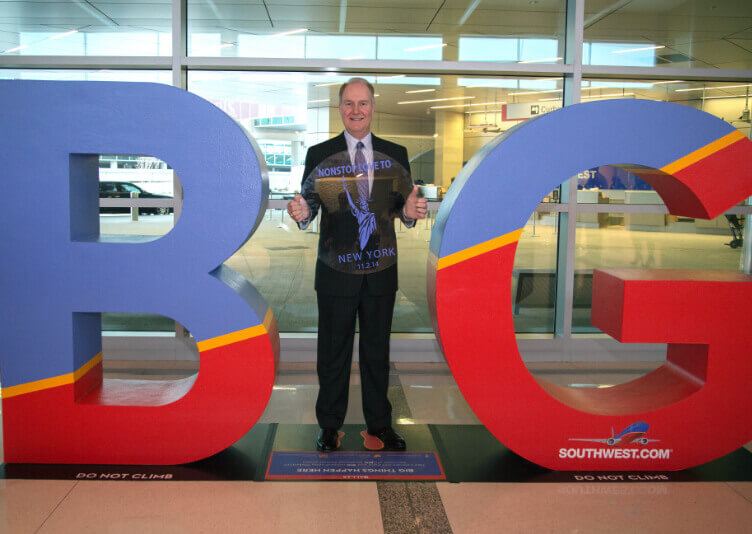
A ramp agent (ca. 2004) welcomes an arriving flight. Whenever Southwest moves into a new market, it disrupts the status quo, encouraging fare competition and stimulating the local economy. This phenomenon is known as the Southwest Effect.
The Ultimate Report Card: The Southwest Effect
Blair, owner of a tour company in Bristol, Connecticut, dialed his print shop in a hurry. They were about to print 350 brochures announcing tours to Nashville for the year 2000, with flights originating in Providence, Rhode Island—nearly two hours away by bus. But Southwest Airlines had just announced plans to open routes from Bradley International Airport in Windsor Locks, Connecticut, 30 minutes from Bristol.
Blair had to stop the presses and revise his brochures. Southwest’s new airport was going to be a game-changer for his business.
Bristol, Hartford, and the surrounding communities in Connecticut were about to experience what the U.S. Department of Transportation (DOT) had dubbed the “Southwest Effect.” While Southwest’s low-cost model had encouraged fare competition in local markets from the beginning, it wasn’t until 1993 that DOT researchers officially turned their focus to studying the phenomenon. Their research found that every time Southwest entered a market, fares dropped by 50 percent and overall passenger traffic more than tripled. At a time when air travel in the United States was dominated by legacy carriers, Southwest was disrupting the status quo.
For Southwest, the goal wasn’t to crush competitor fares; it was to make air travel accessible to ordinary people. Once, when Southwest’s round-trip fare between Dallas and San Antonio was lower than a competitor’s by more than $45, a shareholder asked Founder Herb Kelleher why Southwest wouldn’t raise its fare a few dollars. “You don’t understand,” Herb said. “We’re not competing with other airlines. We’re competing with ground transportation.”
But while Southwest was competing with automobiles, other airlines were trying to keep up with Southwest. In order to compete with the low-cost model that Southwest embraced, legacy carriers were forced to lower their fares whenever Southwest began serving a new market. At the Minneapolis-St. Paul International Airport (MSP), for example, the arrival of Southwest in 2009 drove ticket prices down 32 percent in its first year.
“When there’s a new entry into a market, all airlines are going to have to match the prices,” said MSP’s Public Affairs Director. “Some people will fly the new airline, while others prefer to stick with one of the other airlines because of frequent flyer programs. The size of the pie increases. More people are able to fly because of the lower prices.”
Beyond the obvious impact of lower fares and more accessible travel, the Southwest Effect can have a significant impact on a community: creating new jobs, expanding supplemental services such as hotels and car rental and taxi services, and enticing new businesses to move into an area that has been made more practical for business travel. “The biggest economic boon you can bring to any area is to improve your transportation,” said the head of the Hartford Economic Development Commission.
In the nearly 30 years since the DOT coined the phrase “Southwest Effect,” the industry has changed significantly, with newer low-cost carriers such as Spirit Airlines and JetBlue competing for market share. Southwest is no longer the upstart airline flying short-haul Texas flights. It has grown to become the largest domestic carrier in the United States, based on the DOT’s most recent reporting of domestic originating passengers boarded.
Given these changes, some are asking: Is the Southwest Effect . . . still in effect?
According to recent studies, the answer is a resounding yes—and Dallas, Southwest’s home base, is proof. When the Wright Amendment was fully repealed in 2014, Southwest began flying dozens of new routes out of Love Field, and competitors at Dallas-Fort Worth International Airport cut fares to keep up. Within a few years, traffic at the two airports had increased 37 percent, and air travelers pocketed a combined $920 million in savings from the lower fares.
The Southwest Effect can be harder to spot today because Southwest has already had an impact on fares in so many places, said Executive Vice President and Chief Commercial Officer Andrew Watterson. “The appreciation of the Southwest Effect can diminish over time,” he said. “It’s really obvious when we first come in, but it becomes the new normal. But the economic impact persists, even if the link isn’t drawn as much after a few years.”
Still, with popular Southwest airports such as Nashville, Indianapolis, and Kansas City reporting significant fare reductions and upticks in air travel, the airline that set out to change the airline industry continues to prove that the Southwest Effect is alive and well.

Gary Kelly announces the first 15 new nonstop destinations from Dallas Love Field following the repeal of the Wright Amendment in 2014, prompting competitors at Dallas-Fort Worth International Airport to cut fares to keep up. Within a few years, traffic at the two airports had increased and travelers had pocketed millions in savings from the lower fares.
